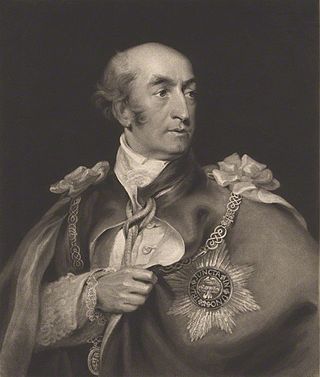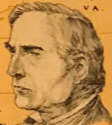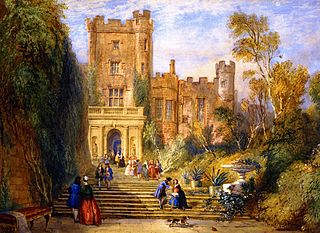Samuel Matthews (died 1802), better known as the Dulwich Hermit, was an 18th-century London hermit, famous for his unresolved 1802 murder.
Contents

Samuel Matthews (died 1802), better known as the Dulwich Hermit, was an 18th-century London hermit, famous for his unresolved 1802 murder.

Matthews was born in south Wales [lower-alpha 1] about 1733, [lower-alpha 2] and came to Dulwich in 1772, being employed as a gardener. He was described as having led a happy domestic life - living with his wife and four children. [5]
Upon the death of his wife in about 1775, he is said to have entered a deep melancholy and have withdrawn from civilization. He solicited and obtained permission from the master and Wardens of Dulwich college to dig cave in Dulwich Wood and erect a hut over it. He went on to live 23 years at the dwelling. He was visited regularly by locals who dubbed him as the Wild Man of the Wood and described him as quiet, friendly and learned man - quite apart from his savage and dirty surroundings. He was often annoyed by mischievous boys and fellows who would steal provisions and throw stones at him. At around 1798, he was beaten by some local Gypsy boys, who broke his arm and robbed him of 12 shillings. While under cure, he became disgusted with his old habitation, and left to spend a year and a half with his son in Wales. [3] [6]
Once he had recovered, he felt an urge to return to Dulwich and once again, obtained permission to build a new hut and cave - the former having been destroyed by Gypsies.
On an unknown day in December 1802, [7] five boys, who at Christmas time, always made a tradition of visiting him, came across the mangled corpse of Matthews near his cave. He had been beaten to death. "[he] was covered with fern and under his arm was an oaken branch about six or seven feet long, which it is supposed the villains put into the cave in order to hook him out…it appears likely the hook had been hitched into his mouth, there being a hole of the size of it quite through the cheek" according to the local newspaper report. [7]
Matthews had been seen the previous night by the local butcher, where he had paid off a small debt. Nearby gypsies were tried as suspects, but none were convicted, leading to the jury's verdict being "wilful murder, by person or persons unknown". [3] [4] [5] [8]

The London Borough of Southwark in South London forms part of Inner London and is connected by bridges across the River Thames to the City of London and London Borough of Tower Hamlets. It was created in 1965 when three smaller council areas amalgamated under the London Government Act 1963. All districts of the area are within the London postal district. It is governed by Southwark London Borough Council.

Dulwich is an area in south London, England. The settlement is mostly in the London Borough of Southwark, with parts in the London Borough of Lambeth, and consists of Dulwich Village, East Dulwich, West Dulwich, and the Southwark half of Herne Hill. Dulwich lies in a valley between the neighbouring districts of Camberwell, Crystal Palace, Denmark Hill, Forest Hill, Peckham, Sydenham Hill, and Tulse Hill.

Upper Norwood is an area of south London, England, within the London Boroughs of Bromley, Croydon, Lambeth and Southwark. It is north of Croydon. The eastern part of it is better known as the Crystal Palace area. The SE19 London postcode covers the entirety of the district.

Herne Hill is a district in south London, approximately four miles from Charing Cross and bordered by Brixton, Camberwell, Dulwich, and Tulse Hill. It sits to the north and east of Brockwell Park and straddles the boundary between the boroughs of Lambeth and Southwark. There is a road of the same name in the area, as well as a railway station.

Blundell's School is an independent co-educational boarding and day school in the English public school tradition, located in Tiverton, Devon. It was founded in 1604 under the will of Peter Blundell, one of the richest men in England at the time, and moved to its present site on the outskirts of the town in 1882.

John Blaquiere, 1st Baron de Blaquiere, KCB, PC, known as Sir John Blaquiere, Bt. from 1784 to 1800, was a British soldier, diplomat and politician of French descent. He served as Chief Secretary for Ireland between 1772 and 1776

Gipsy Hill in south London is a hilly and leafy neighbourhood spanning the southern parts of the London Boroughs of Lambeth and Southwark characterised for its stunning views of the City of London and Dulwich.

West Dulwich is a neighbourhood in South London on the southern boundary of Brockwell Park, which straddles the London Borough of Lambeth and the London Borough of Southwark. Croxted Road and South Croxted Road mark the boundary between Southwark to the east and Lambeth to the west. The suburb of West Dulwich dates back to the 17th century when the often flooded land known as Dulwich Common was acquired and drained by Edward Alleyn's estate.

Dulwich Wood, together with the adjacent Sydenham Hill Wood, is the largest extant part of the ancient Great North Wood in the London Borough of Southwark. The two woods were separated after the relocation of The Crystal Palace in 1854 and the creation of the high level line in 1865. The wood is privately owned and managed by the Dulwich Estate.

The Great North Wood was a natural oak woodland that started three miles (4.8 km) south-east of central London and scaled the Norwood Ridge. At its full extent, the wood's boundaries stretched almost as far as Croydon and as far north as Camberwell. It had occasional landownings as large clearings, well-established by the Middle Ages such as the hamlets of Penge and Dulwich.

Samuel Ross Mason, also spelled Meason, was a Virginia militia captain, on the American western frontier, during the American Revolutionary War. After the war, he became the leader of the Mason Gang, a criminal gang of river pirates and highwaymen on the lower Ohio River and the Mississippi River in the late 18th and early 19th centuries. He was associated with outlaws around Red Banks, Cave-in-Rock, Stack Island, and the Natchez Trace.

John Joseph Merlin was a Freemason, clock-maker, musical-instrument maker, and inventor from the Prince-Bishopric of Liège in the Holy Roman Empire. He moved to England in 1760. By 1766 he was working with James Cox and creating automatons such as Cox's timepiece and the Silver Swan. By 1773 he was designing and making innovative keyboard instruments. In 1783 he opened Merlin's Mechanical Museum in Princes Street, Hanover Square, London, a meeting-place for the gentry and nobility. In addition to his clocks, musical instruments and automata, Merlin is credited with the invention of inline skates in the 1760s. He was referred to by contemporaries as "The Ingenious Mechanic". He was friendly with composer Joseph Haydn.

Sydenham Hill Wood is a ten-hectare wood on the northern slopes of the Norwood Ridge in the London Borough of Southwark. It is designated as a Local Nature Reserve and Site of Metropolitan Importance for Nature Conservation. With the adjacent Dulwich Wood, Sydenham Hill Wood is the largest extant tract of the ancient Great North Wood. The two woods are formed from coppices known as Lapsewood, Old Ambrook Hill Wood and Peckarmans Wood after the relocation of The Crystal Palace in 1854 and the creation of the high level line in 1865.
The Peckham Boys, also referred to as Black Gang, is a multi-generational gang based in Peckham, South London. The gang is particularly prominent for its members prolific activity in music. Giggs, once a member of the SN1 set, is generally credited with popularising the British gangsta rap style known as road rap. Giggs would proceed to have a successful musical career, and re-form SN1 as a record label. In 2011, Peckham Boys rapper Stigs was given the first ever gang injunction, banning him from making any music that may encourage violence. Stigs was at the time allegedly a member of Anti GMG. In 2011, Southwark Council identified three sets of the Peckham Boys, PYG, Anti GMG and SN1, as the most active gangs in the Peckham area.

John Locke was an English barrister, author and Liberal Party politician.

Dulwich Cranbrook is a co-educational independent school for children aged 2–16 near Cranbrook, Kent. Since September 2023, the Head has been Sophie Bradshaw.

David Cox, known as David Cox the Younger, David Cox II or David Cox Jr. to distinguish him from his better-known father David Cox (1783-1859), was an English painter in watercolour, mostly of landscapes.

The Crown and Greyhound is a Grade II listed public house at 73 Dulwich Village, Dulwich, London. It is classified by CAMRA as a pub with a regionally important historic interior. The pub is affectionately referred to by locals as "The Dog", and sometimes as "The Dog and Hat". The pub is particularly noteworthy for its post-war connection to the British poetry movement. It is described by Nikolaus Pevsner as, "a cheerfully cross gabled pub".

Dulwich Community Hospital was a hospital located in Dulwich, in South London.
Samuel Mathews or Matthews may refer to: